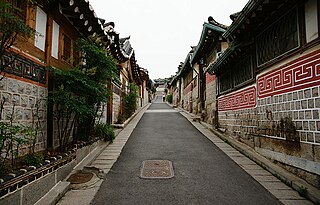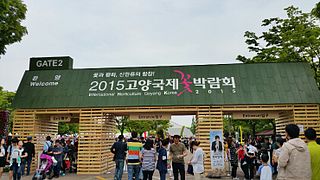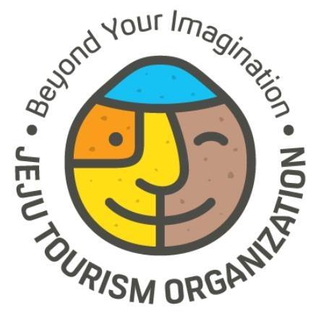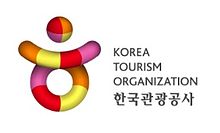
Tourism in Japan is a major industry and contributor to the Japanese economy.

Tourism in Australia is an important part of the Australian economy, and comprises domestic and international visitors. Australia is the fortieth most visited country in the world according to the World Tourism Organization. In the financial year 2018/19, tourism was Australia's fourth-largest export and over the previous decade was growing faster than national GDP growth. At the time it represented 3.1% of Australia's GDP contributing A$60.8 billion to the national economy.

The N Seoul Tower, officially the YTN Seoul Tower and commonly known as Namsan Tower or Seoul Tower, is a communication and observation tower located on Nam Mountain in central Seoul, South Korea. The 236-meter (774 ft)-tall tower marks the second highest point in Seoul and is considered a local landmark.

Mount Kumgang or the Kumgang Mountains is a mountain massif, with a 1,638-metre-high (5,374 ft) peak, in Kangwon-do, North Korea. It is located on the east coast of the country, in Mount Kumgang Tourist Region, formerly part of Kangwŏn Province, and is part of the Taebaek mountain range which runs along the east of the Korean Peninsula. The mountain is about 50 kilometres (31 mi) from the South Korean city of Sokcho in Gangwon-do.

The Mount Kumgang Tourist Region is a special administrative region of North Korea. It is geographically coterminous with Kumgang County, Kangwon Province. It was established in 2002 to handle South Korean tourist traffic to Mount Kumgang. It was one of the symbols of the South Korean Sunshine Policy.

Tourism in the United Kingdom is a major industry and contributor to the U.K. economy, which is the world's 10th biggest tourist destination, with over 40.1 million visiting in 2019, contributing a total of £234 billion to the GDP.

Tourism in South Korea refers to the tourist industry in the Republic of Korea. In 2012, 11.1 million foreign tourists visited South Korea, making it the 20th most visited country in the world, and the 5th most visited in Asia. Most non-Korean tourists come from other parts of East Asia such as Japan, China, Taiwan, and Hong Kong. The recent popularity of Korean popular culture, often known as the "Korean Wave", in these countries has increased tourist arrivals. Seoul is the principal tourist destination for visitors; popular tourist destinations outside of Seoul include the major coastal city of Busan, the Seorak-san national park, the historic city of Gyeongju and subtropical Jeju Island. Traveling to North Korea is not normally possible without a special permission.

Seorae Village, sometimes nicknamed "Montmartre", due to its hilltop location, or sometimes "French Village", is a small, affluent French ethnic enclave in Banpo-dong & Bangbae-dong, Seocho-gu, Seoul, South Korea. It is home to about 560 French people, roughly 40% of the French community in South Korea. Most of them are employees of French corporations doing business in the country. The majority (370) of the French population are children.

Jongno District is a district in central Seoul, South Korea. It takes its name from a major local street, Jongno, which means "Bell Road".

Tourism in China is a growing industry that is becoming a significant part of the Chinese economy. The rate of tourism has expanded over the last few decades since the beginning of reform and opening-up. The emergence of a newly rich middle class and an easing of restrictions on movement by the Chinese authorities are both fueling this travel boom. China has become one of world's largest outbound tourist markets. According to Euromonitor International, economic growth and higher incomes in nearby Asian countries will help China to become the world's number one tourist destination by 2030.

Bukchon Hanok Village is a Korean traditional village in Seoul with a long history located on the top of a hill between Gyeongbok Palace, Changdeok Palace and Jongmyo Royal Shrine. The traditional village is composed of many alleys, hanok and is preserved to show a 600-year-old urban environment.
The Seoul Tourism Awards event was established in South Korea by the Seoul Metropolitan Government in 2008 to showcase Seoul as a tourist destination and to recognize the contributions of individual members and companies of the travel industry in developing Asia Pacific tourism.
South Korea maintains a visa waiver agreement list and a designated visa-free entry list with countries not included on those lists requiring a visa to enter the country. In addition, foreigners wishing to engage in certain activities such as diplomatic work, gainful employment, study or residence must apply for the appropriate visa prior to engaging in that activity in country.
Fashion tourism is a niche market segment evolved out of three major sectors: Creative Tourism, Cultural Tourism and Shopping Tourism. Fashion Tourism can be defined as “the interaction between Destination Marketing Organizations (DMOs), trade associations, tourism suppliers and host communities, with people travelling to and visiting a particular place for business or leisure to enjoy, experiment, discover, study, trade, communicate about and consume fashion.”

The Goyang International Flower Festival is one of the largest flower festivals in South Korea and takes place in the city of Goyang. It attracts many visitors annually. The festival is held in a metropolitan area and serves as a model for local culture festivals, in which some foreign flower farmers participate.

Kazakhstan is the ninth-largest country by area and the largest landlocked country. Tourism is not a major component of the economy. As of 2014, tourism has accounted for 0.3% of Kazakhstan GDP, but the government had plans to increase it to 3% by 2020.
The Seoul Tourism Organization is a public interest corporation established by local governments in Seoul, South Korea. It's also called a Seoul Tourism Foundation. The organization was established on May 1, 2018. The purpose of the organization is to make Seoul an international tourist city. It is linked with Korea Tourism Organization.

The Jeju Tourism Organization (JTO) is a public company associated with Jeju Special Self-Governing Province in the Republic of Korea. It is tasked with promoting Jeju Island's tourism industry domestically and internationally.
South Korea attracted more than 2.76 million foreign patients as of 2019, since the attraction of international patients began in 2009. Among many reasons for the increasing number of patients, there are benefits such as reasonable medical costs, high quality medical services, short waiting times, and tourism packages combining relaxation and tourism.














